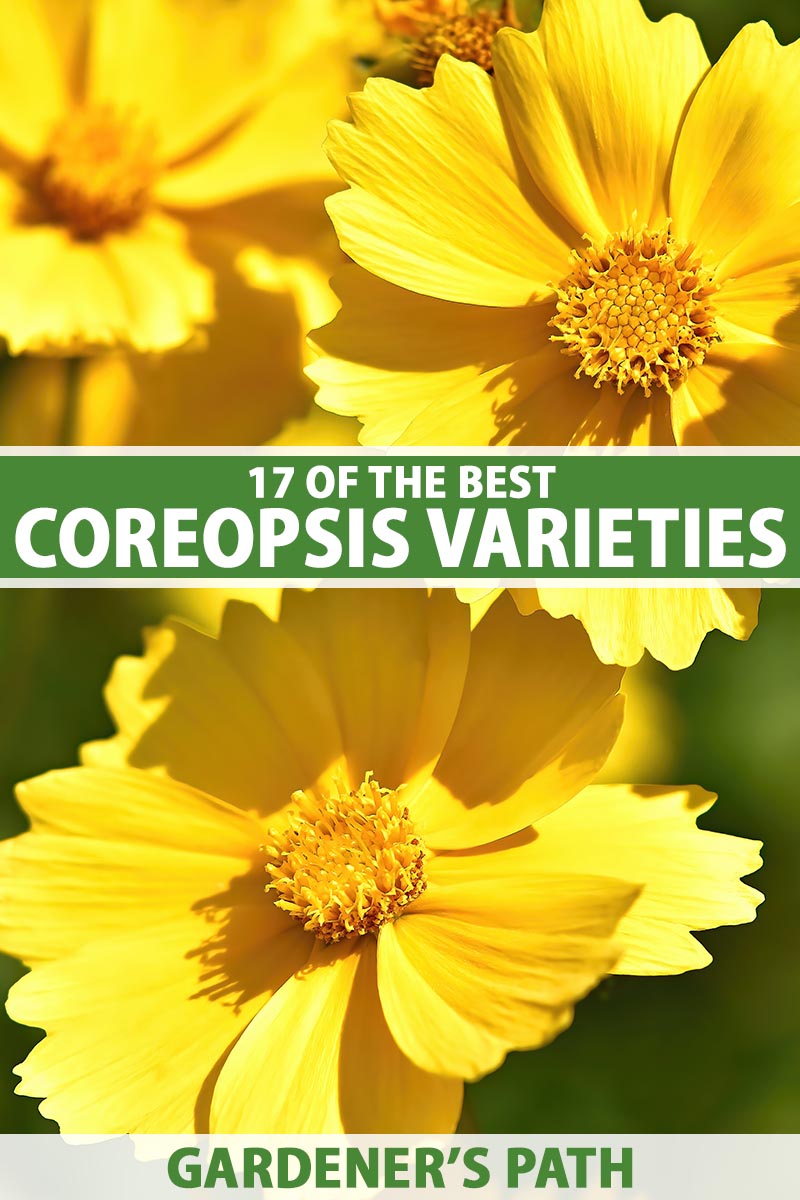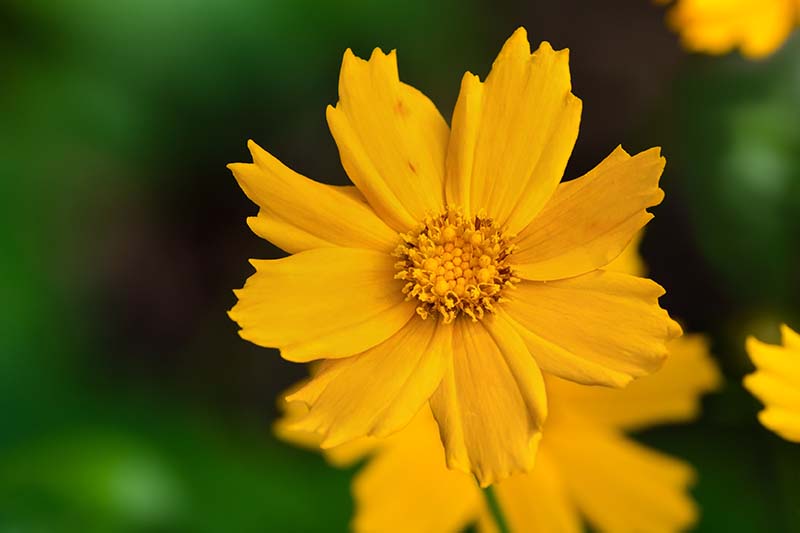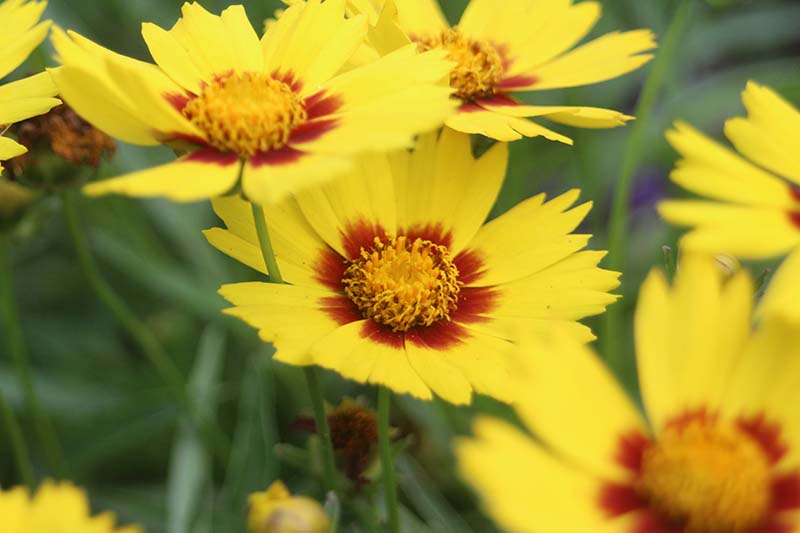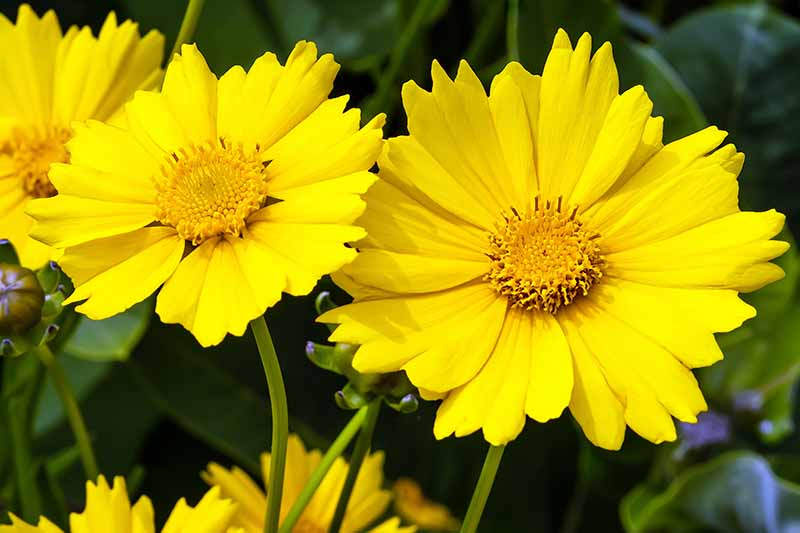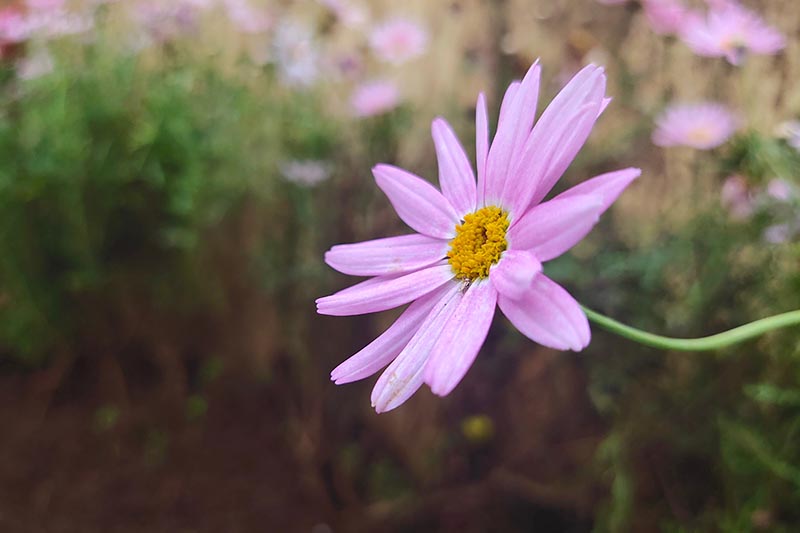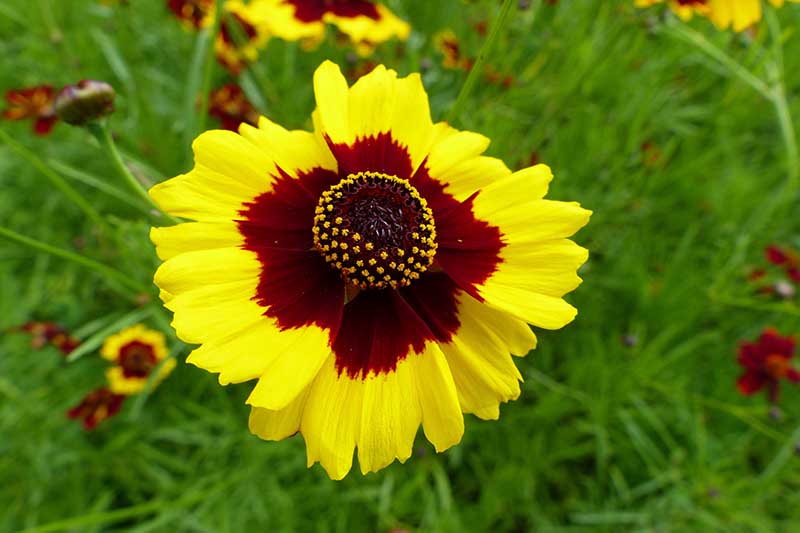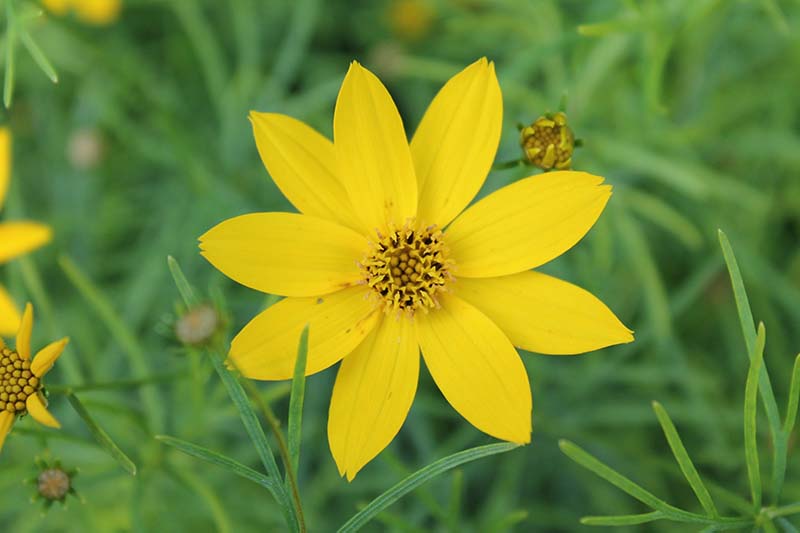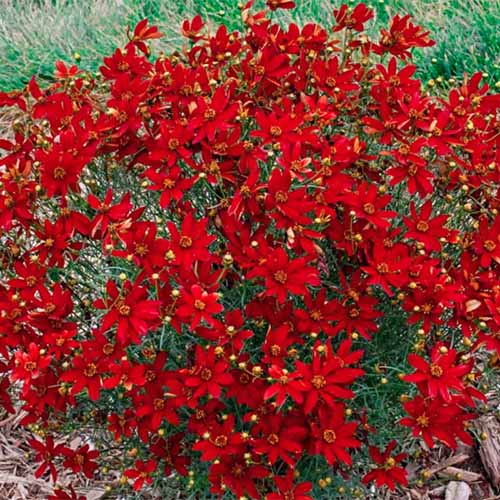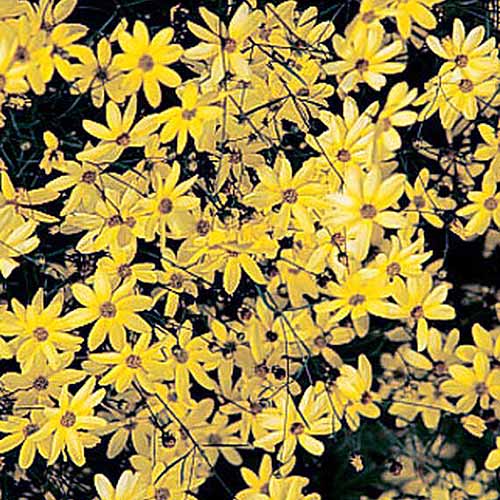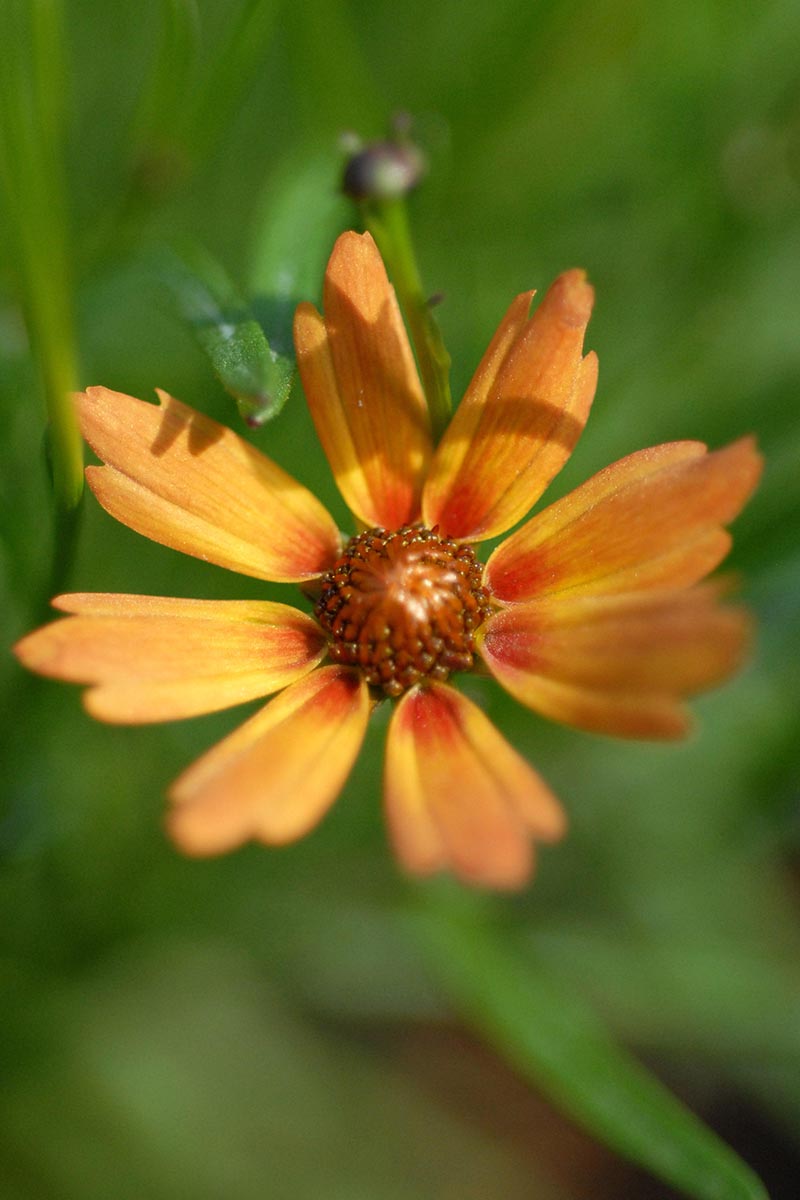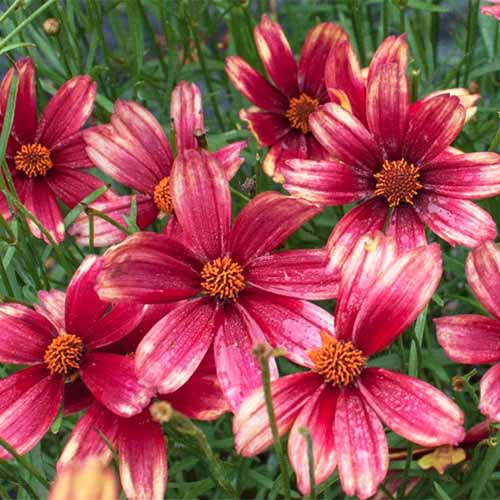Native to North America, coreopsis comes in a pleasing array of colors, heights, hardiness suitabilities, and textures. The daisy-like blooms are often perennial, although some varieties are annuals. Breeders have been playing around with different variations for years, resulting in dozens of choices to suit every gardener, and nearly every climate zone. We link to vendors to help you find relevant products. If you buy from one of our links, we may earn a commission. Here are the 17 recommended varieties we’ll introduce to you:
A Note About Species
Before we dive into the heart of this roundup, let’s briefly meet six of the main species from which many varieties come.
C. auriculata
Native to the lower 48 states, particularly those in the east and southeast, C. auriculata is also known as “lobed tickseed” or “mouse-ear tickseed.” A low-growing species, it’s considered a dwarf variety. Cultivars can grow anywhere from four to 12 inches tall, sometimes up to 24 inches in height, with a spread of six to 12 inches. The wide, ovate leaves have two small lobes at the base, giving them the appearance of mouse ears. The bright yellow, toothed flowers are usually one to two inches in diameter, or sometimes three inches. They bloom in April and May. Like strawberries, this species is stoloniferous, meaning it spreads by putting out runners, so you might get a whole field of C. auriculata blooms if you’re patient.
C. grandiflora
Also called “large-flowered coreopsis,” C. grandiflora bears toothed flowers that are one to three inches in diameter. Native to much of Canada and the United States, this species is widespread as a wildflower in eastern Canada, Oklahoma, and Arkansas. This short-lived perennial grows one to two feet tall and spreads up to two feet. C. grandiflora is caespitose, or clump-forming, and while it doesn’t tend to last longer than a few years as a perennial, it reseeds very easily. The leaves are wide and slightly grass-like. Flowers are usually yellow with a central disk that’s often a maroon or burgundy color. One of the best qualities of C. grandiflora is its long blooming season; this species and its cultivars produce flowers from late May to late August!
C. lanceolata
Known as “lance-leaf coreopsis,” this species is native to the eastern and central parts of the United States but has naturalized all over, from Canada and the western United States to Australia, Japan, parts of South America, and South Africa. C. lanceolata has narrow, lanceolate leaves and bright yellow, finely toothed flowers that are one to two inches in diameter. It grows wild along roadsides, and in meadows and fields. This sunny species grows and spreads one to two feet, and blooms from May to July.
C. rosea
This pleasing rosy-hued species is the one that plant breeders use to help broaden the color range of the available cultivars, with a native range from Nova Scotia down through Maryland. It grows one to two feet tall and spreads one and a half to two and a half feet. With thin, grass-like leaves, these delicately toothed pink blooms with yellow centers look like they belong in a fairy garden. They have a nice long bloom time, too, producing small flowers from half an inch to an inch across from June to September.
C. tinctoria
Named for the way its bright red and yellow petals make a perfect dye for coloring fabrics, C. tinctoria, also called “dyer’s coreopsis” or “golden tickseed,” is native to the western United States. An annual, C. tinctoria reseeds easily and has spread in the wild, naturalizing in the eastern and central United States. With one- to two-inch flowers that bloom from June to September, this variety is often called “plains coreopsis.” It grows to between two and four feet tall and spreads one to one and a half feet.
C. verticillata
Often called “threadleaf coreopsis” due to its thin, threadlike leaves, or “whorled tickseed” thanks to the way the leaves are arranged in a whorled pattern around the axis, C. verticillata has yellow, very faintly toothed flowers that are one to two inches in diameter. Native to the eastern United States, this plant grows to between two and a half and three and a half feet tall, and spreads one and a half to two feet. Like C. rosea, it blooms from June to September. Now that you’ve met the important players in the coreopsis world, let’s get started with 17 of our favorite varieties! The central disks are red and yellow, too, and they complement the petals. ‘Amulet’ An annual that blooms in the spring and keeps flowering all summer, ‘Amulet’ grows just 10 to 12 inches tall and spreads eight to 12 inches. It grows best in USDA Hardiness Zones 2 to 10. Find packets of seeds available at Eden Brothers.
2. Crazy Cayenne
If you’re one of those people who feels life can never have enough spice, meet ‘Crazy Cayenne.’ This perennial C. verticillata cultivar is part of an aptly named series, Sizzle & Spice® by plant breeders at Walters Gardens. Amazingly enough, this cultivar is the same red-orange color as the actual spice, cayenne pepper. Each petal is pleated from the pointed tip to the center for a pretty, textured look. ‘Crazy Cayenne’ grows 15 to 18 inches tall and spreads 20 to 26 inches. The flowers are one and three quarters of an inch in diameter, and bloom from early to late summer. ‘Crazy Cayenne’ This cultivar is hardy in Zones 5 through 9. Get a head start on your garden with bare root plants from Spring Hill Nurseries, available via the Home Depot.
3. Double Sunburst
This one’s for sunshine lovers everywhere. With its two-inch, butter yellow, semi-double and double flowers, C. lanceolata ‘Double Sunburst’ is a perennial sure to make any passersby feel joyous. Including you! Really, you’ll feel cheered up every time you walk by the sunny blooms on your way into or out of your home. ‘Double Sunburst’ ‘Double Sunburst’ grows up to a whopping 24 to 36 inches tall, with a similar spread. It’ll bloom from early to midsummer until the first fall frost hits, and then it’ll come back next year to cheer you up again. Hardy in Zones 4 through 9, you can find seeds available from Botanical Interests.
4. Hot Paprika
You wanted more spice in your life – right? Meet C. verticillata ‘Hot Paprika,’ another member of the Sizzle & Spice® series. With dainty, dark red blooms that are one and a half inches in diameter, ‘Hot Paprika’ offers a bright dash of fire to add to any garden. Plant it alongside yellow yarrow for a stunning display of color and visual texture. ‘Hot Paprika’ ‘Hot Paprika’ grows 15 to 18 inches tall and spreads 22 to 26 inches. It’s a perennial, hardy in Zones 5 through 9, and it blooms from early to late summer. You can find bare root plants from Spring Hill Nurseries via the Home Depot.
5. Mardi Gras
For a cultivar as fun as the celebration it’s named for, C. tinctoria ‘Mardi Gras’ is the coreopsis for revelers everywhere. A snazzy touch, its slim petals curl downward. ‘Mardi Gras’ petals are yellow with a bright red splash at the base of each, forming a disk of color around the flower head. ‘Mardi Gras’ ‘Mardi Gras’ is an annual dwarf variety, so it’s perfect for a container garden. It grows 12 to 18 inches tall, spreads eight to 12 inches, and is hardy in Zones 2 through 10. You can expect this flashy cultivar to bloom from early spring to late summer. You can find seeds available from Eden Brothers.
6. Mercury Rising
Unlike other red-flowered cultivars, ‘Mercury Rising’ is not a C. tinctoria cultivar, but rather, a variety of C. rosea. It also has a bright yellow center, unlike some of the other crimson varieties, which gives it a striking appearance almost like a red daisy. The edges of the petals are subtly frosted in a bluish color, which adds to the appeal. As part of the classic Big Bang™ series, introduced by Massachusetts hybridizer Darrell Probst of Walters Gardens, this C. rosea cultivar possesses better disease resistance than other varieties of Coreopsis, even in warm, wet growing conditions. ‘Mercury Rising’ The flowers are one and a half to two inches across, and they bloom reliably from early summer to early fall. The plant grows 15 to 18 inches tall and spreads 24 to 36 inches. A perennial, ‘Mercury Rising’ is hardy in Zones 5 through 9.
7. Moonbeam
Is there a more classic variety than ‘Moonbeam’? I think not. With pale yellow flowers that look like splashes of moonlight in your garden, it’s easy to see why this C. verticillata cultivar won the Perennial Plant Association’s Plant of the Year Award in 1992. ‘Moonbeam’ ‘Moonbeam’ grows up to two feet tall and spreads up to two feet wide. Flowers are one to two inches in diameter, and they bloom from June to August. ‘Moonbeam’ is hardy in Zones 3 through 9. Live plants are available from Burpee.
8. Pumpkin Pie
Are you one of those pumpkin spice latte lovers who runs out to get one as soon as they become available each year? Perfect for anyone who craves a bit of autumnal magic all summer long, ‘Pumpkin Pie’ delights with its soft, one-inch, pumpkin-orange petals that give way to strips of yellow and reddish-orange at the center. A C. verticillata hybrid that’s a cross between pink ‘Rum Punch’ and copper-colored ‘Little Penny,’ ‘Pumpkin Pie’ was bred by Harini Korlipara at Terra Nova Nurseries in Canby, Oregon. ‘Pumpkin Pie’ is a low-growing, wide-spreading variety that offers a medley of enticing fall colors. It only grows to be about seven inches tall and spreads 20 inches. It’s the perfect perennial for those in warmer zones, as it’s only hardy in Zones 9 and 10. Elsewhere, it may be grown as a perennial.
9. Radiana Tigrina
This one’s for the lovers of tie-dye, creativity, and color. With C. lanceolata ‘Radiana Tigrina,’ prominent, rounded flower heads give way to skinny, red petals striped at the edges with yellow. The two- to three-inch flowers are as snazzy, artsy, and fun as they sound. ‘Radiana Tigrina’ A dwarf cultivar, ‘Radiana Tigrina’ is a short-lived perennial hardy in Zones 4 through 9. It grows to about 12 to 18 inches in height, and spreads eight to 12 inches. Find packets of seeds available from Eden Brothers.
10. Red Chiffon
Are you a lover of elegance and style? Then you’ll want to plant ‘Red Chiffon’ in your flowerbed. This member of the Satin & Lace™ series by Massachusetts breeder Darrell Probst is as fancy as they come. A C. verticillata hybrid, ‘Red Chiffon’ has petals that are dark pink toward the center, and pale pink and yellow at the edges. It’s a sterile, long-blooming hybrid, flowering from early summer through early fall, and like other Satin & Lace™ varieties of coreopsis, it’s extra resistant to powdery mildew. ‘Red Chiffon’ ‘Red Chiffon’ grows to between 15 and 18 inches tall, with a spread of 18 to 24 inches. You can find potted plants available from the Home Depot in quart-size containers.
11. Red Elf
If you’re thinking that if there’s a Big Bang, there must be a Li’l Bang somewhere, you’d be right. Massachusetts hybridizer Darrell Probst, master of all things coreopsis, cultivated this series as well. Like the varieties in the Big Bang™ collection, plants in this series also offer a long bloom time and resistance to disease. With its pleated, wine-colored petals and bright yellow center disks, ‘Red Elf’ is my favorite of the Li’l Bang™ cultivars. ‘Red Elf’ is a compact variety that grows between eight and 12 inches tall and spreads 12 to 18 inches, blooming prolifically with two-inch flowers from late spring to mid-fall. ‘Red Elf’ A perennial, ‘Red Elf’ is hardy in Zones 5 through 9. Other popular members of this series include ‘Starstruck,’ ‘Starlight,’ and ‘Daybreak.’ Find live plants in three-gallon pots available from Nature Hills Nursery.
12. Red Satin
Want a lovely red jewel to plant among your yellow coreopsis for stunning contrast, or on its own against a yellow, tan, or gray house or garage for a truly dazzling effect? ‘Red Satin’ is the bloom for you. With dainty, ruby-red petals on 15- to 18-inch stems, these tall beauties nod and bend in the breeze. They spread 18 to 22 inches, are hardy in Zones 5 through 9, and bloom from early summer all the way into the fall. ‘Red Satin’ Developed by – you guessed it, Darrell Probst – as part of his PermaThread™ series, the threadleaf foliage on ‘Red Satin’ gives it an extra delicate look that’s perfect for rock gardens, borders, and large containers. Live plants in one-gallon containers are available from Nature Hills Nursery.
13. Sterntaler
A cheerful variety that isn’t stern at all, German-bred ‘Sterntaler’ (C. lanceolata) boasts bright, golden flowers with a slim loop of red-brown color in the center of each bloom. A perennial, ‘Sterntaler’ blooms from early summer to early fall, and is hardy in Zones 4 through 9. The name for this bloom means “star money” in German, and may refer to a Brothers Grimm story in which a girl gives away all her clothes to people in need and ends up standing naked in a forest. Kind of strange, but then stars fall around her and turn into coins – or “Talers,” as silver coins were called in 15th through 19th century in Germany. With the coins, the girl buys all the clothes she wants. Phew! ‘Sterntaler’ As is typical of a lanceleaf, the leaves are long and pointed at the tips. If you want to turn your lawn or yard into a wildflower garden, ‘Sterntaler,’ with its large, two- to three-inch blooms, can help you accomplish that feat. ‘Sterntaler’ grows 12 to 15 inches tall and spreads 12 to 16 inches wide. You can find seeds available from Eden Brothers.
14. Sunburst
If you’re like me, you might think single-flowered blooms are lovely, but semi-double or double blooms are exquisitely beautiful. Sound like you? Then you’ll adore C. lanceolata ‘Sunburst,’ a cultivar with showstopping golden, two- to three-inch, semi-double blooms. This variety is also one of the taller ones, growing to a height of three feet with a spread of 12 to 18 inches. ‘Sunburst’ Hardy in Zones 4 through 9, ‘Sunburst’ is a perennial that blooms from midsummer through early fall. I have a dark red house, and I think the contrasting flowers of ‘Sunburst’ would look absolutely stunning in my flower garden, or yours. You can find seeds available at Eden Brothers.
15. Sunfire
If you love the idea of a semi-double coreopsis like ‘Sunburst,’ but want a bloom with a little more color, try C. grandiflora ‘Sunfire.’ The yellow, two-inch, semi-double blooms sport a narrow band of red at the base of each petal near the center of the flower. ‘Sunfire’ These aren’t showy blooms, like ‘Radiana Tigrina,’ but subtly pretty ones that can add a dash of joy to any flower garden. A perennial that’s hardy in Zones 4 through 9, ‘Sunfire’ grows 18 to 24 inches tall with a spread of 12 to 18 inches. Seeds are available from True Leaf Market.
16. Tall Red
For a breathtaking annual that readily reseeds, try ‘Tall Red,’ a variety of plains coreopsis (C. tinctoria) with wide, one to two-inch red petals. This stunning wildflower grows up to three feet tall, with a spread of one to one and a half feet. ‘Tall Red’ ‘Tall Red’ is hardy in Zones 2 through 11, and blooms from early- to midsummer through the first fall frost. Plant it along a walkway for a bright welcome to your home! You can find seeds available from Eden Brothers.
17. Zagreb
A twin to ‘Moonbeam’ in all but color, C. verticillata ‘Zagreb’ is bright yellow where ‘Moonbeam’ is pale. This popular cultivar looks magnificent next to purple or blue flowers, so consider planting it in a bed of lavender or Faassen’s catmint. ‘Zagreb’ grows up to 15 inches tall and spreads 12 to 15 inches wide. A perennial, hardy in Zones 3 through 9, ‘Zagreb’ is a tough, low-maintenance beauty with one to two-inch flowers that bloom from May to June, and will rebloom in the fall after a late-summer shearing of spent blossoms. ‘Zagreb’ This cultivar won the Royal Horticultural Society’s Award of Garden Merit in 2001, and you can find live plants in one-gallon containers at Nature Hills Nursery.
Comely Coreopsis
No matter which variety (or three) you select for your flower bed, you’re sure to enjoy the beauty of this pleasing plant. The steadily flowering, gorgeous colors are an instant mood-lifter. What is your favorite coreopsis variety? And if you have any questions, let us know in the comments section below! And for more information about growing coreopsis in your garden, check out these guides next:
How to Grow and Care for CoreopsisHow to Prepare Coreopsis for Winter
